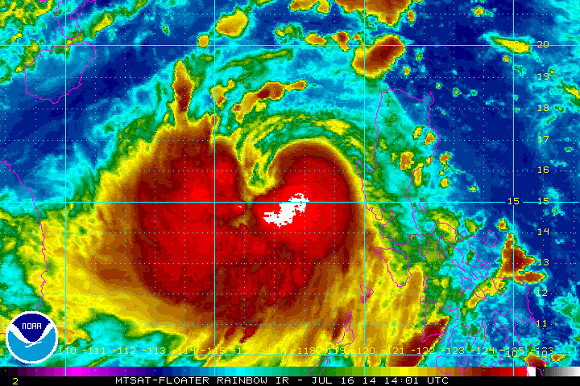Typhoon Rammasun
Status: Closed
Post Landfall 1 | Summary
Posting Date: July 16, 2014, 12:30:00 PM
Typhoon Rammasun Passes South of Manila, Expected to Strengthen Before Hitting Hainan
Weakening as it crossed the Philippine island of Luzon, Typhoon Rammasun passed to the south of Manila, where wind speeds of 60-140 km/hr (~37-87 mph) were observed, along with heavy rainfall. Rammasun has since emerged over the South China Sea and is beginning to reorganize as it heads on a west-northwest track around the periphery of the subtropical ridge.
In the Philippines the storm toppled trees and power lines, leaving half of the island of Luzon without power and prompting the evacuation of more than 370,000 people. Rammasun brought storm surge to Manila Bay, but there have been no reports of major flooding to the Metro Manila area. Government offices, financial markets, and schools closed for the day but are expected to reopen Thursday. At least 20 deaths across the Philippines have been blamed on Rammasun.
Meteorological Summary and Forecast
Typhoon Rammasun (also known as Glenda in the Philippines) made landfall in the Philippine province of Sorsogon between 8 and 9 UTC July 15 as a strong typhoon with a central pressure of 945 mb and maximum 10-minute sustained winds of 157 km/h (~98 mph), according to the Japan Meteorological Agency (JMA). Typhoon Rammasun weakened as it traversed the Philippine island of Luzon, with its central pressure increasing from 945 to 960 mb. At its closest pass to Manila, Rammasun had reported wind speeds of up to 140 km/h (~87 mph). Rammasun is currently reorganizing over the South China Sea on a west-northwest track.
Interaction with land has led to degradation in the typhoon structure (see satellite image), although warm sea surface temperatures and favorable upper-level conditions should allow for gradual reintensification over the South China Sea.

Infrared satellite image of Rammasun over the South China Sea, at 14:01 UTC. (Source: NOAA)
As of 12:50 UTC July 16, the JMA forecast continued motion to the west-northwest, with landfall occurring in Hainan Province, China, at approximately 6 UTC July 18 with a central pressure of 950 mb. The storm is then forecast to cross the Gulf of Tonkin prior to landfall in Vietnam.

Figure 2. Forecast track of Rammasun (Source: JMA)
Reported Impacts
Rammasun moved through a heavily populated area of the Philippines. Major roads across Luzon were blocked by debris, fallen trees, electricity poles, and tin roofs that had been ripped off village houses. At least four southeastern provinces on Luzon declared, or were preparing to declare, a state of calamity, allowing the local governments to tap emergency relief funds. Officials reported at least 20 deaths elsewhere. The winds also tore down shanty homes in areas where hundreds of thousands of people live along Manila Bay.
Nearly 400 flights were grounded during a four-hour closure of Manila International Airport. Two airliners suffered minor damage, airport officials said. Train services in the capital remained suspended because of the lack of power.
At least 4,000 ferry passengers and 50 vessels have been stranded in ports. Ferry services were to resume later in the day, including to the holiday island of Boracay where 300 tourists were stranded.
In Tacloban, the city hit hardest by Typhoon Haiyan last year, 5,335 families, or nearly 27,000 people, had been affected by the storm, but there have been no reports of significant damage in the area.
Exposure at Risk in the Philippines and Mainland China
While reinforced masonry structures are typical, light materials—such as wood frames with galvanized iron and aluminum roofs—are frequently used for residential buildings in rural areas of the Philippines, making them more vulnerable when compared with those in neighboring Hong Kong or Taiwan. Homes constructed of light material may experience moderate- to high-level cladding and roofing damage, involving loss of roof covering, as well as the removal of porch coverings and awnings; some of these homes could even be destroyed. In extreme instances, some structurally deficient buildings can collapse. Building codes are not strictly enforced. In the Luzon area one- to two- story buildings of mixed construction (concrete and wood) are common.
In Manila, high-rise commercial and apartment buildings are generally built to stricter code requirements. In addition, commercial and apartment buildings usually have stronger foundations than residential buildings, and these foundations provide a stronger resistance to flood loads. Flood is much more damaging to the lower floors of a multi-story building and many apartment buildings in Southeast Asia have commercial establishments on the first floor. Balconies and sliding glass doors, which are common in apartment buildings, increase the vulnerability to heavy winds.
Houses in coastal regions of southern China are commonly confined masonry or reinforced concrete with clay tile roofs, which perform reasonably well in the face of typhoon winds. Insurance take-up for typhoon coverage is low in China, particularly for residential risks. When there is coverage, wind and flood generally are covered together in the same policy. As is often the case with China typhoons, flooding is a major concern; with much of the population located near waterways and along the coast, many homes and businesses are at risk.
The AIR tropical cyclone team will continue to monitor Typhoon Rammasun and will provide updates as necessary.